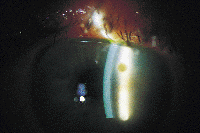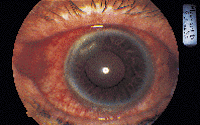Culturing still valuable despite increasingly effective
[sidebar: How to make culturing a part of your practice]
The commercial availability of fluoroquinolones to treat a wide variety of infections has led some doctors to abandon the practice of culturing ocular infections and corneal ulcers. While these antibiotics can eliminate most organisms that affect the eye, some infections will not be resolved by the use of fluoroquinolones. In these instances, obtaining a sample of the material from the ulcer can allow practitioners to determine the organism that has caused the condition and what the most effective antibiotic treatment will be.
Treatment of an ocular infection with antibiotics will effectively sterilize the eye, limiting the yield produced when the culture is incubated in the laboratory. Doctors recommend obtaining a culture sample of a suspicious infection or ulcer, then beginning treatment with fluoroquinolones until the culture results are returned.
When to culture
 ---Feathery or Discolored infiltrates could suggest a fungal ulcer, which would be cultured.
---Feathery or Discolored infiltrates could suggest a fungal ulcer, which would be cultured.
Among the determinations in deciding when to culture are the severity of the infection, whether the infection or ulcer is an atypical presentation and how the patient has responded to previously initiated treatment, said Joseph P. Shovlin, OD, in private practice in Scranton, Pa., in an interview with Primary Care Optometry News.
The conditions Dr. Shovlin feels require mandatory culturing include hyperacute conjunctivitis, cases of possible neonatal conjunctivitis and atypical presentations such as ring or radial nerve infiltrates. If a patient has a severe case of dacryocystitis that is being drained, this material should be cultured.
Corneal ulcers that meet certain criteria also should be cultured, Dr. Shovlin said. If there is a history of organic trauma, if the patient presentation is atypical for a corneal ulcer or in cases of suspected rare infections, such as feathery discolored infiltrates, the optometrist should obtain a sample. For example, a brown infiltrate or a satellite lesion or infiltrate should make the practitioner suspect a fungal keratitis. If the ulcer does not respond to seemingly appropriate therapy, it should be cultured after discontinuation of therapy.
| Perform a Culture if the Following Conditions Exist: | ||
|
Patients who have compromised immune systems or who have been hospitalized and may be exposed to different infectious organisms also should have cultures taken of ulcers.
Some other situations where the practitioner should at least consider a culture would be in patients with chronic conjunctivitis, epidemic conjunctivitis or any type of atypical external disease, Dr. Shovlin said.
Christopher Quinn, OD, in private group practice in Iselin, N.J., told Primary Care Optometry News he prefers to err on the side of caution when determining if a patient needs to be cultured.
“In my experience, you’re never sorry that you obtained a culture, but you may be sorry some day for not having obtained one. If in doubt, I think you should culture,” he said.
Determine potential effect on vision
 ---If Hyperacute or neonatal conjunctivitis is suspected, or if the ulcer does not respond to initial treatment, the lesion should be cultured, even if it is not near the visual axis.
---If Hyperacute or neonatal conjunctivitis is suspected, or if the ulcer does not respond to initial treatment, the lesion should be cultured, even if it is not near the visual axis.
The location and depth of the ulcer or infection and its potential effect on vision also play a role in determining when to obtain a culture.
When the lesion is located in the visual axis, William D. Townsend, OD, in private practice in Canyon, Texas, will refer the patient to a corneal specialist because the condition likely will require surgery. Any infection that is paracentral or near the visual axis should always be cultured, he said.
Any time there is a 25% depth infiltration or the cornea has a 50% thinning process, regardless of where on the cornea the infection is, a culture should be obtained, Dr. Shovlin said.
For all patients with one eye, Dr. Townsend will take a culture sample unless the ulcer is very small and is located in the periphery of the cornea.
Fluoroquinolone regimen
 ---Corneal ulcers located paracentrally or those that compromise vision should always be cultured.
---Corneal ulcers located paracentrally or those that compromise vision should always be cultured.
After obtaining a culture sample, Dr. Townsend begins a heavy regimen of fluoroquinolones. For the first 2 to 3 hours, he prescribes one drop of Ocuflox (ofloxacin, Allergan) or Ciloxan (ciprofloxacin HCl, Alcon) every 15 minutes. “That’s for the first day, because you want to stop the growth of the organism and begin killing it,” he said. At night, he has the patient apply Ciloxan ointment as long as they are on antibiotics.
The next day, the patient begins taking the drops on an hourly basis. “Most lesions will get better, and you will see improvement by the second day,” he said.
Some lesions may worsen even after therapy has begun, particularly pseudomonas infections, Dr. Shovlin said. A key question in determining the effectiveness of treatment is asking the patient “Does the eye feel better?” he said.
Treatment of the eye with fluoroquinolones before a culture is taken will result in a smaller yield in the laboratory, which will often lead to a delay in diagnosis and providing the proper treatment, Dr. Shovlin said.
“If optometrists do not culture and they have the clinical impression that they should culture, then do not treat the patient if he or she can get to a referral center in a timely fashion. I’m not saying don’t treat if you can’t get the patient to a referral center for 5 days, but if you can get somebody in that afternoon, then my recommendation would be to not treat until the ulcer has been cultured,” he said.
Empiric vs. culture-driven therapy
The two competing philosophies in treating ocular infections either base their therapeutic regimen on the results of the culture or rely on the broad-spectrum capabilities of fluoroquinolones, Dr. Shovlin said. With single-agent therapy, combined with an additional agent for gram-positive coverage, practitioners will achieve about a 96% cure rate, he said, compared with fortified dual-agent antibiotics, which have a cure rate of about 98%. Most practitioners are leaning toward the fluoroquinolones, which are commercially available and have less toxicity, for gram-negative coverage and either regular or fortified-strength cephalosporin for gram-positive coverage.
“Even though broad-spectrum coverage is often efficacious, cultures are sometimes very helpful to guide the modification of therapy in patients with suboptimal or lack of response to treatment and, most importantly, in some cases, to decrease toxicity by eliminating the ineffective drugs,” Dr. Shovlin said.
Dr. Quinn agreed that, despite the success of the fluoroquinolones, they have not eliminated the need for culturing. “The whole issue goes back to the fact that we have good therapy [with fluoroquinolones] that will work 90% of the time. That’s one of the main arguments for culturing in my mind — because that treatment works 90% of the time, it means that with one out of 10 patients, it’s not going to work. I’m not comfortable with one out of 10 and not having an adequate culture,” he said.
On the other hand, if the empiric therapy instituted before the culture results were obtained is successful, those results are of little use, Dr. Quinn said.
“They’re interesting, and you may determine the organism that’s responsible, but you’re not going to change a therapy that’s working,” he said. “It’s in the small percentage of cases where the results of the culture come back and your therapy is not working that the culture is most useful. In those cases, you can look at the antibiotic sensitivity testing that’s been performed on the culture isolate and find out the most effective antibiotic to use. Then, you can change your therapy.”
For Your Information:
- Joseph P. Shovlin, OD, is in private practice at the Northeastern Eye Institute and is an Editorial Board member of Primary Care Optometry News. He can be reached at 200 Mifflin Ave., Scranton, PA 18503; (717) 342-3145; fax: (717) 344-1309; e-mail: jshovlin@aol.com. Dr. Shovlin has no direct financial interest in the products mentioned in this article. He is a paid consultant for Alcon.
- Christopher Quinn, OD, is in private practice at Omni Eye Services. He can be reached at 485 Rte. 1, Ste. A, Iselin, NJ 08830; (732) 750-0400; fax: (732) 750-1507; e-mail: cqod@home.com. Dr. Quinn has no direct financial interest in the products mentioned in this article, nor is he a paid consultant for any companies mentioned.
- William D. Townsend, OD, practices in Canyon, Texas, and serves as a consultant at the Veterans Affairs Medical Center in Amarillo. He can be reached at 1801 4th Ave., Ste. C, Canyon, TX 79015; (806) 655-7748; fax: (806) 655-5871; doctorbill@amaonline.com. Dr. Townsend has no direct financial interest in the products mentioned in this article, nor is he a paid consultant for any companies mentioned.
